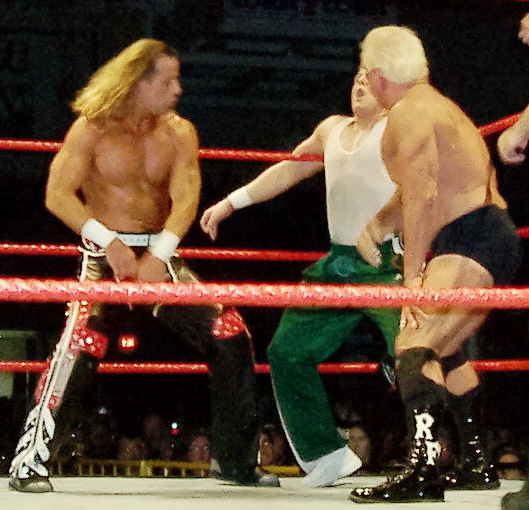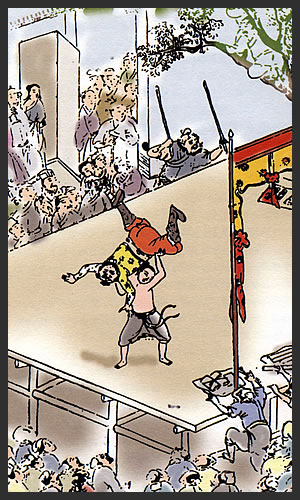|
Karate Chop
In martial arts, a knifehand strike is a strike using the part of the hand opposite the thumb (from the little finger to the wrist), familiar to many people as a karate chop (in Japanese, ''shutō-uchi''). Suitable targets for the knifehand strike include the carotid sinus at the base of the neck (which can cause unconsciousness), mastoid muscles of the neck, the jugular, the throat, the collar bones, ribs, sides of the head, temple, jaw, the third vertebra (key stone of the spinal column), the upper arm, the wrist (knifehand block), the elbow (outside knifehand block), and the knee cap (leg throw). In many Japanese, Korean, and Chinese styles, the knifehand is used to block as well as to strike. Japanese martial arts is a term from Japanese martial arts like aikido and Chinese-Okinawan martial arts like karate and Shorinji Kempo referring to a hand position that resembles that of the blade of a sword. This can be in a high, middle or low position but is usually extended outwa ... [...More Info...] [...Related Items...] OR: [Wikipedia] [Google] [Baidu] |
Martial Arts
Martial arts are codified systems and traditions of combat practiced for a number of reasons such as self-defence; military and law enforcement applications; combat sport, competition; physical, mental, and spiritual development; entertainment; and the preservation of a nation's intangible cultural heritage. The concept of martial arts was originally associated with East Asian tradition, but subsequently the term has been applied to practices that originated outside that region. Etymology "Martial arts" is a direct English translation of the Sino-Japanese word (, ). Literally, it refers to "武 martial" and "芸 arts". The term ''martial arts'' was popularized by mainstream popular culture during the 1960s to 1970s, notably by Hong Kong action cinema, Hong Kong martial arts films (most famously those of Bruce Lee) during the so-called "chopsocky" wave of the early 1970s. According to John Clements, the term '':wikt:martial art, martial arts'' itself is derived from an older ... [...More Info...] [...Related Items...] OR: [Wikipedia] [Google] [Baidu] |
Tori (martial Arts)
is a term used in Japanese martial arts to refer to the executor of a technique in partnered practice. The term "tori" comes from the verb , meaning "to take", "to pick up", or "to choose". In judo and some other martial arts, ''tori'' is the person who completes the technique against the training partner, called '' uke''. Regardless of the situation, the principle is that "tori" is always the one who successfully ''completes'' a technique. The terms "tori" and "uke" are not synonymous with attacker and defender, because the role is determined by who completes a successful technique, not who initiates one. In aikido Aikido ( , , , ) is a gendai budō, modern Japanese martial art which is split into many different styles including Iwama Ryu, Iwama Shin Shin Aiki Shuren Kai, Shodokan Aikido, Yoshinkan, Renshinkai, Aikikai, and Ki Aikido. Aikido is now practic ... and related martial arts, ''tori'' executes a defensive technique against a designated attack initiated by ''uke''. ... [...More Info...] [...Related Items...] OR: [Wikipedia] [Google] [Baidu] |
Spy Film
The spy film, also known as the spy thriller, is a film genre, genre of film that deals with the subject of fictional espionage, either in a realistic way (such as the adaptations of John le Carré) or as a basis for fantasy (such as many James Bond in film, James Bond films). Many novels in the spy fiction genre have been adapted as films, including works by John Buchan, le Carré, Ian Fleming (Bond) and Len Deighton. It is a significant aspect of Cinema of the United Kingdom, British cinema, with leading British directors such as Alfred Hitchcock and Carol Reed making notable contributions and many films set in the Secret Intelligence Service, British Secret Service. Spy films show the espionage activities of government agents and their risk of being discovered by their enemies. From the Nazi espionage thrillers of the 1940s to the James Bond films of the 1960s and to the high-tech blockbusters of today, the spy film has always been popular with audiences worldwide. Offering ... [...More Info...] [...Related Items...] OR: [Wikipedia] [Google] [Baidu] |
Professional Wrestling Attacks
Strikes can be offensive moves in professional wrestling, that can sometimes be used to set up an opponent for a hold or for a throw. There are a wide variety of strikes in pro wrestling, and many are known by several different names. Professional wrestlers frequently give their finishers new names. Occasionally, these names become popular and are used regardless of the wrestler performing the technique. Professional wrestling contains a variety of punches and kicks found in martial arts and other fighting sports; the moves listed below are more specific to wrestling itself. Many of the moves below can also be performed from a raised platform (the top rope, the ring apron, etc.); these are called aerial variations. Moves are listed under general categories whenever possible. Body press A maneuver that involves a wrestler attacking with the core of the body. It is executed from an upright, running position using momentum and weight to run over the opponent. Body avalanche The w ... [...More Info...] [...Related Items...] OR: [Wikipedia] [Google] [Baidu] |
Professional Wrestling
Professional wrestling, often shortened to either pro wrestling or wrestling,The term "wrestling" is most often widely used to specifically refer to modern scripted professional wrestling, though it is also used to refer to Real life, real-life wrestling combat. is a form of athletic theaterEero Laine (2017). "Stadium-sized theatre: WWE and the world of professional wrestling". In #refChowEtAl2017, Chow et al. (2017). ''Performance and Professional Wrestling'', p. 39: "The business of professional wrestling is the business of theatre. Even if on the surface professional wrestling seems anathema to theatrical sensibilities, it is hard to deny the formal similarities. After all, professional wrestling is scripted entertainment performed live in front of an audience by actors portraying characters." centered around mock combat with the premise that its performers are competitive wrestlers. In the United States, the term "professional wrestling" does not refer to authentic wrest ... [...More Info...] [...Related Items...] OR: [Wikipedia] [Google] [Baidu] |
Kazushi Sakuraba
is a Japanese professional wrestler, submission wrestling, submission wrestler and former mixed martial artist, currently signed to Pro Wrestling NOAH, Pro Wrestling Noah, where he was formerly one-half of the former GHC Tag Team Championship, GHC Tag Team Champions with Takashi Sugiura. He has also competed in traditional puroresu for New Japan Pro-Wrestling (NJPW) and shoot wrestling, shoot-style competition for UWFi and Kingdom Professional Wrestling, Kingdom Pro Wrestling (KPW). He has fought in MMA competition in the Ultimate Fighting Championship, Pride Fighting Championships, Hero's, Dream (mixed martial arts), Dream and most recently Rizin Fighting Federation. He is known as the Gracie Hunter or the Gracie Killer due to his wins over four members of the famed Gracie family: Royler Gracie, Renzo Gracie, Ryan Gracie, and Royce Gracie. Sakuraba is famous for beating 15 champions of different top MMA organizations; opponents who were often many weight-classes above him. Known ... [...More Info...] [...Related Items...] OR: [Wikipedia] [Google] [Baidu] |
Mixed Martial Arts
Mixed martial arts (MMA) is a full-contact fighting combat sport, sport based on strike (attack), striking and grappling; incorporating techniques from various combat sports from around the world. In the early 20th century, various inter-stylistic contests took place throughout Japan and the countries of East Asia. At the same time, in Brazil there was a phenomenon called vale tudo, which became known for unrestricted fights between various styles such as judo, Brazilian jiu-jitsu, catch wrestling, luta livre, Muay Thai and capoeira. An early high-profile mixed bout was Masahiko Kimura vs. Hélio Gracie, Kimura vs Gracie in 1951. In mid-20th century Hong Kong, rooftop street fighting contests between different martial arts styles gave rise to Bruce Lee's hybrid martial arts style Jeet Kune Do. Another precursor to modern MMA was the 1976 Muhammad Ali vs. Antonio Inoki, Ali vs. Inoki exhibition bout, fought between boxer Muhammad Ali and wrestler Antonio Inoki in Japan, where ... [...More Info...] [...Related Items...] OR: [Wikipedia] [Google] [Baidu] |
Poomsae
The Korean terms hyeong, pumse, poomsae and teul (meaning "form" or "pattern") are all used to refer to martial arts forms that are typically used in Korean martial arts such as Taekwondo and Tang Soo Do. * Hyeong (형) is often romanized as ''hyung''. This term is used primarily in earlier styles of taekwondo, often referred to as ''traditional taekwondo''. * Pumse (품세) is often romanized as ''poomsae'' or ''poomse''. This term is used primarily in Kukkiwon/World Taekwondo Federation, WTF-style taekwondo. * Teul (틀) is often romanized as ''tul''. This term is used primarily in International Taekwon-Do Federation, ITF-style taekwondo. A hyeong is a systematic, prearranged sequence of martial techniques that is performed either with or without the use of a weapon. In traditional dojangs (training halls), hyeong are used primarily as a form of interval training that is useful in developing mushin (mental state), mushin, proper kinetics and mental and physical fortitude. Hye ... [...More Info...] [...Related Items...] OR: [Wikipedia] [Google] [Baidu] |
Taegeuk (taekwondo)
In taekwondo, taegeuk is a set of '' Pumsae'' (also known as ''Poomsae'' or ''Poomse''), or defined pattern of defense-and-attack forms used to teach taekwondo. Between 1967 and 1971, Kukkiwon-style taekwondo made use of an older set of forms called the '' palgwae'' forms developed by the Korea Taekwondo Association (KTA) with input from some of the original nine '' kwans'' of taekwondo. By 1970, additional kwans had joined the KTA so the newer set of taegeuk forms was developed to better represent inputs from all the participating kwans. By 1971, the palgwae forms were considered to be deprecated in favor of the newer taegeuk forms, though some schools still teach palgwae forms as well. All World Taekwondo Federation (WTF) Pumsae competitions use the taegeuk pumsae, along with 8 of the black belt Pumsae. To gain a black belt, a student generally must know all eight Taegeuk Poomsae and also be able to perform all of them consecutively with no breaks in between. Each Taege ... [...More Info...] [...Related Items...] OR: [Wikipedia] [Google] [Baidu] |
World Taekwondo Federation
World Taekwondo, formerly the World Taekwondo Federation, is an international federation governing the sport of Taekwondo and Para Taekwondo. WT is a member of the Association of Summer Olympic International Federations (ASOIF). The World Taekwondo Federation was established on 28 May 1973, at its inaugural meeting held at the Kukkiwon with participation of 35 representatives from around the world. there are 213 member nations. Since 2004, Choue Chung-won has been the president of World Taekwondo, succeeding the first president, Kim Un-yong. World Taekwondo (WT) was recognized by the International Paralympic Committee (IPC) on October 16, 2013, and the IPC later included taekwondo in the Tokyo 2020 Summer Paralympics. On 17 July 1980, the International Olympic Committee (IOC) recognized World Taekwondo Federation at its 83rd Session in Moscow, Russia. Taekwondo debuted as a demonstration sport of the 1988 Summer Olympics in Seoul, South Korea. On 4 September 1994, Taekwon ... [...More Info...] [...Related Items...] OR: [Wikipedia] [Google] [Baidu] |
Abductor Digiti Minimi Muscle Of Hand
In human anatomy, the abductor digiti minimi (abductor minimi digiti, abductor digiti quinti, ADM) is a skeletal muscle situated on the ulnar border of the palm of the hand. It forms the ulnar border of the palm and its spindle-like shape defines the hypothenar eminence of the palm together with the skin, connective tissue, and fat surrounding it. Its main function is to pull the little finger away from the other fingers (i.e. abduction). Structure The abductor digiti minimi arises from the pisiform bone, the pisohamate ligament, and the flexor retinaculum. Its distal tendon ends in three slips that are inserted into the ulnopalmar margin of the proximal phalanx, the palmar plate of the metacarpophalangeal joint, and the sesamoid bone when present. Some fibers insert into the finger's dorsal aponeurosis, which is why the muscle acts similar to a dorsal interosseus muscle. Additionally, the ulnar-most portion of the tendon inserts into the little finger's digital cord, ... [...More Info...] [...Related Items...] OR: [Wikipedia] [Google] [Baidu] |
Taekwondo
Taekwondo (; ; ) is a Korean martial art and combat sport involving primarily kicking techniques and punching. "Taekwondo" can be translated as ''tae'' ("strike with foot"), ''kwon'' ("strike with hand"), and ''do'' ("the art or way"). In addition to its five tenets of courtesy, integrity, perseverance, self-control and indomitable spirit, the sport requires three physical skills: ''poomsae'' (, Form), ''kyorugi'' (, Sparring) and ''gyeokpa'' (, Breaking Technique). Poomsae are patterns that demonstrate a range of kicking, punching and blocking techniques, kyorugi involves the kind of sparring seen in the Olympics, and gyeokpa is the art of breaking wooden boards. Taekwondo also sometimes involves the use of weapons such as swords and nunchucks (nunchaku). Taekwondo practitioners wear a uniform known as a . Taekwondo is a combat sport which was developed during the 1940s and 1950s by Korean martial artists with experience in martial arts such as karate and Chinese martial ar ... [...More Info...] [...Related Items...] OR: [Wikipedia] [Google] [Baidu] |





